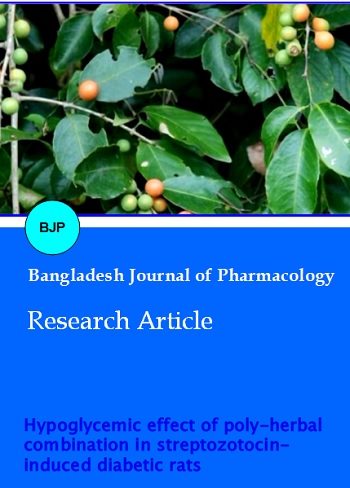Hypoglycemic effect of poly-herbal combination in streptozotocin-induced diabetic rats
DOI:
https://doi.org/10.3329/bjp.v11i2.24855Keywords:
Diabetes, Hypoglycemic, Poly-herbal, StreptozotocinAbstract
The present study evaluates the combinatorial effect of a poly-herbal combination with multiple therapeutic effects as a hypoglycemic and hypolipidemic agent. Herbal combination of Salacia oblonga, Tinospora cordifolia, Emblica officinalis, Curcuma longa and Gymnema sylvestre was prepared and administered to streptozotocin (55 mg/kg, i.p.)-induced diabetic rats, at a dose of 100 mg/kg, for four weeks. The poly-herbal combination significantly elevated the plasma insulin (90%) and reduced serum glucose (42%), cholesterol (49%), triglycerides (43%), LDL cholesterol (62.5%) and plasma apo B/apo A in the diabetic rats. The liver lipogenic enzymes like HMG CoA reductase and glucose-6-phosphatase significantly declined (p<0.05) in their activity while glucose-6-phosphate dehydrogenase and malic enzymes showed higher activity compared to the diabetic control. The results suggest a significant hypoglycemic and hypolipidemic property for the poly-herbal combination.
Downloads
413
356 Read
226

Published
How to Cite
Issue
Section
License
Authors who publish with this journal agree to the following terms:
- Authors retain copyright and grant the journal right of first publication with the work simultaneously licensed under a Creative Commons Attribution License that allows others to share the work with an acknowledgement of the work's authorship and initial publication in this journal.
- Authors are able to enter into separate, additional contractual arrangements for the non-exclusive distribution of the journal's published version of the work (e.g., post it to an institutional repository or publish it in a book), with an acknowledgement of its initial publication in this journal.
- Authors are permitted and encouraged to post their work online (e.g., in institutional repositories or on their website) prior to and during the submission process, as it can lead to productive exchanges, as well as earlier and greater citation of published work (See The Effect of Open Access).
